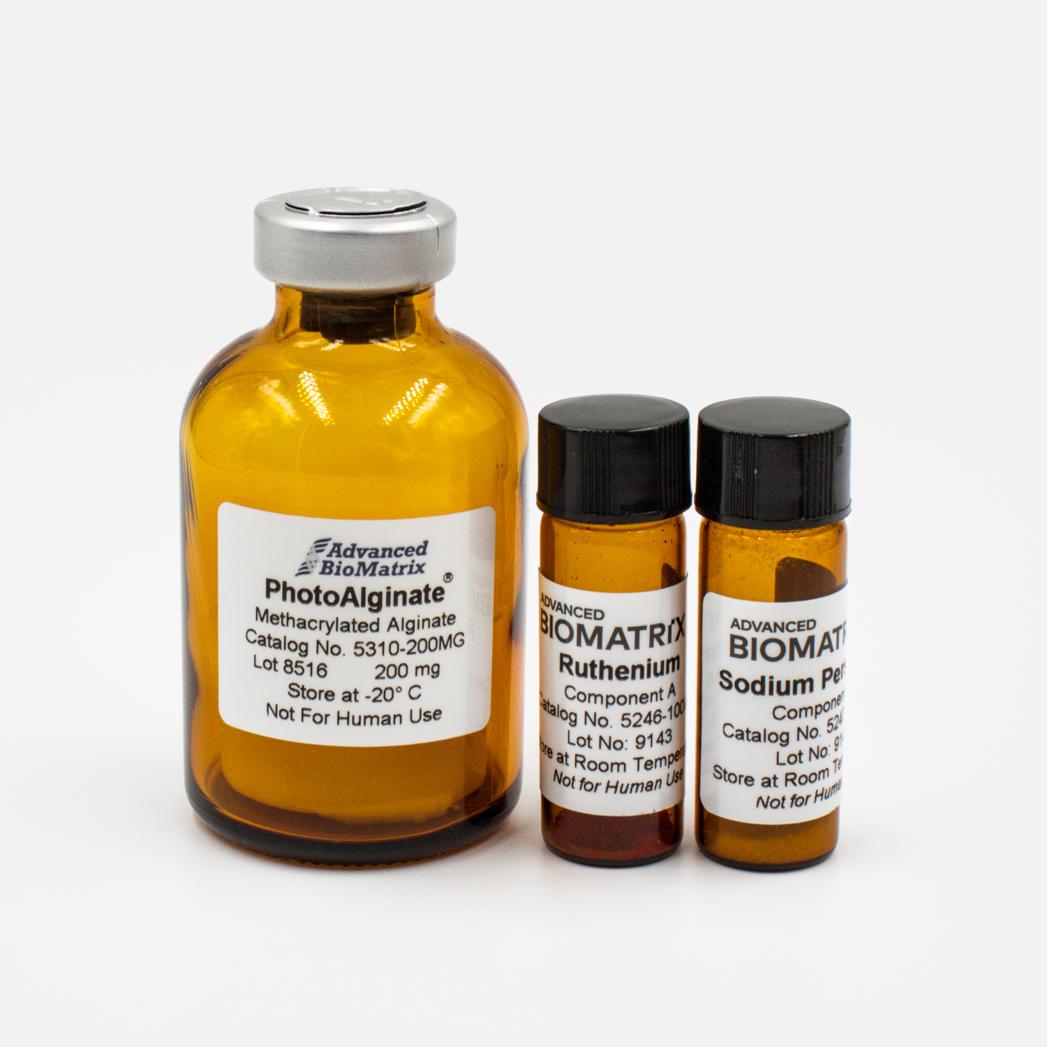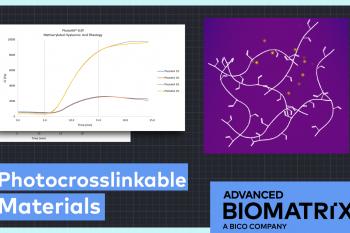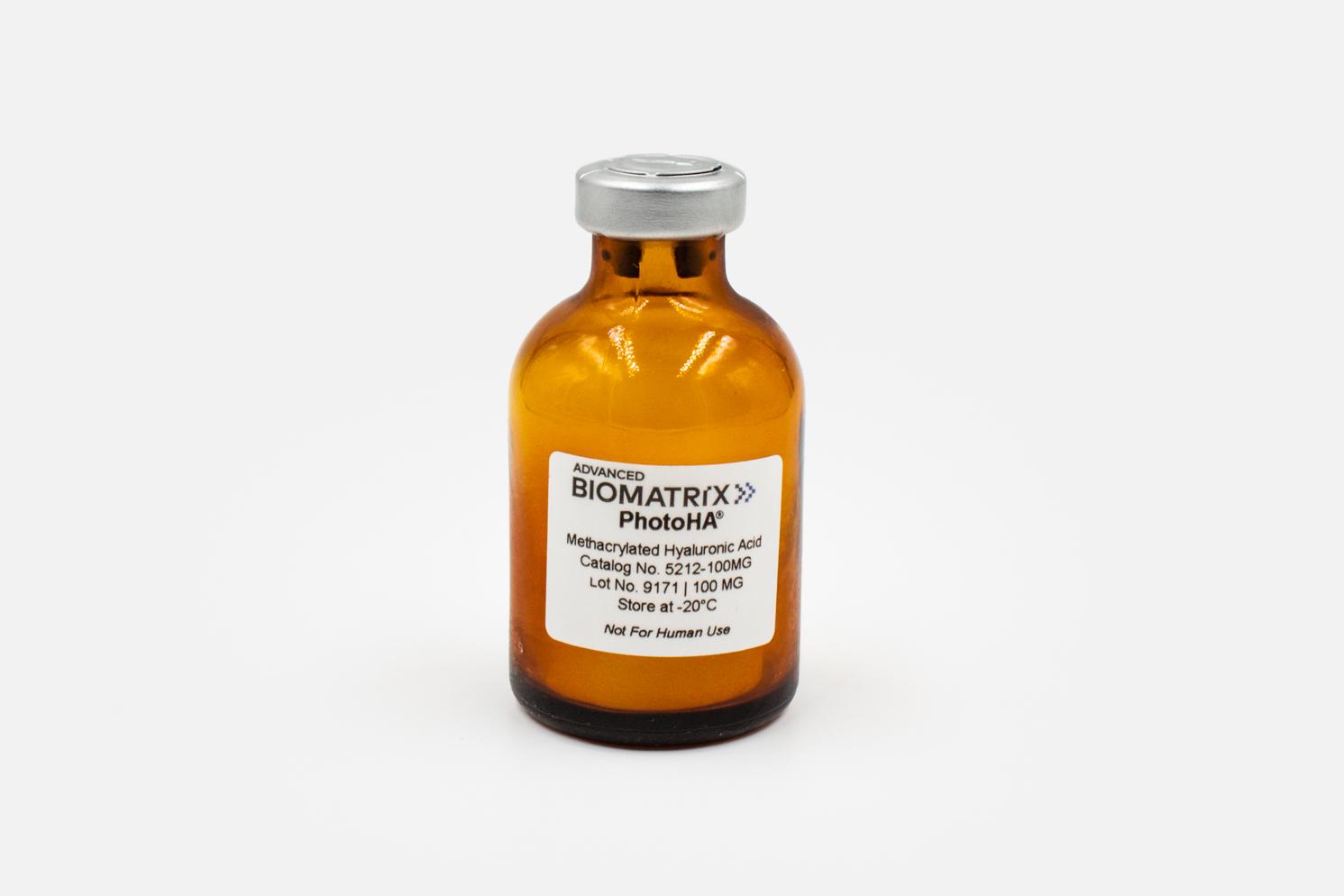-
Collagen
-
Type I - Atelocollagen
- PureCol® Solution, 3 mg/ml (bovine) #5005
- Nutragen® Solution, 6 mg/ml (bovine) #5010
- FibriCol® Solution, 10 mg/ml (bovine) #5133
- PureCol® EZ Gel, Solution, 5 mg/ml (bovine) #5074
- PureCol® Lyophilized, 15 mg (bovine) #5006
- VitroCol® Solution, 3 mg/ml (human) #5007
- VitroCol® Lyophilized, 15 mg (human) #5008
-
Type I - Telocollagen
- TeloCol®-3 Solution, 3 mg/ml (bovine) #5026
- TeloCol®-6 Solution, 6 mg/ml (bovine) #5225
- TeloCol®-10 Solution, 10 mg/ml (bovine) #5226
- RatCol™ for 2D and 3D, Solution, 4 mg/ml (rat) #5153
- RatCol™ High Concentration, Solution, 10 mg/ml (rat)
- RatCol™ lyophilized, 100 mg (rat)
- RatCol™ for Coatings, Solution, 4 mg/ml (rat) #5056
- Type I - Insoluble Collagen
- Type I - Bioinks
- Type II Collagen
- Type III Collagen
- Type IV Collagen
- Collagen Standard
-
PureCol® Collagen Coated Plates
- Collagen Coated T-25 Flasks #5029
- Collagen Coated 6-well Plates #5073
- Collagen Coated 12-well Plates #5439
- Collagen Coated 24-well Plates #5440
- Collagen Coated 48-well Plates #5181
- Collagen Coated 96-well Plates #5072
- Collagen Coated 384-well Plates #5380-5EA
- Collagen Coated 100 x 20 mm Dishes #5028
- MatTek Glass-Bottom Dishes
- MatTek Multi-Well Plates
- Collagen Scaffolds
- Collagen Hybridizing Peptides
-
Type I - Atelocollagen
- Tunable Stiffness
- CytoSoft™ Rigidity Plates
-
Bioprinting
- Support Slurry for FRESH Bioprinting
-
Bioinks for Extrusion Bioprinting
- Lifeink® 200 Collagen Bioink (35 mg/ml) #5278
- Lifeink® 220 Collagen Bioink (70 mg/ml) #5343
- Lifeink® 240 Acidic Collagen Bioink (35 mg/ml) #5267
- Lifeink® 260 Acidic Collagen Bioink (70 mg/ml) #5358
- GelMA Bioink
- GelMA A Bioink
- GelMA C Bioink
- Pluronic F-127 40% Sterile Solution
- GelMA 20% Sterile Solution
- Alginate 5% Sterile Solution
- Photoinitiators
- Bioinks for BIONOVA X
- Bioinks for Lumen X
- DLP Printing Consumables
-
Create Your Own Bioinks
- PhotoCol® Methacrylated Collagen
- PhotoGel® Methacrylated Gelatin 95% DS
- PhotoGel® Methacrylated Gelatin 50% DS
- PhotoHA®-Stiff Methacrylated Hyaluronic Acid
- PhotoHA®-Soft Methacrylated Hyaluronic Acid
- PhotoAlginate® Methacrylated Alginate
- PhotoDextran® Methacrylated Dextran
- PEGDA (Various Molecular Weights)
- Silk Fibroin, Solution
- PhotoSericin® Methacrylated Sericin
- Bioprinters
-
3D Hydrogels
- Thermoreversible Hydrogel
- Silk Fibroin
-
Type I Collagen for 3D Hydrogels
- PureCol® Solution, 3 mg/ml (bovine) #5005
- Nutragen® Solution, 6 mg/ml (bovine) #5010
- FibriCol® Solution, 10 mg/ml (bovine) #5133
- PureCol® EZ Gel, Solution, 5 mg/ml (bovine) #5074
- VitroCol® Solution, 3 mg/ml (human) #5007
- TeloCol®-3 Solution, 3 mg/ml (bovine) #5026
- TeloCol®-6 Solution, 6 mg/ml (bovine) #5225
- TeloCol®-10 Solution, 10 mg/ml (bovine) #5226
- RatCol® for 3D gels, Solution, 4 mg/ml (rat) #5153
- HyStem® Thiolated Hyaluronic Acid
- Methacrylated Collagen
- Methacrylated Gelatin
- Methacrylated Hyaluronic Acid
- Diacrylates
- Collagen Sponges
- Methacrylated Polysaccharides
- Spheroids and Organoids
- Extracellular Matrices
- HyStem / Hyaluronic Acid
-
Adhesion Peptides / Proteins
-
Recombinant Adhesion Proteins
- CD2, 0.5 mg/ml #5086
- CDH3, 0.5 mg/ml #5124
- CDH13, 0.5 mg/ml #5125
- CD14, 0.5 mg/ml #5089
- CDH18, 0.5 mg/ml #5090
- CD40, 0.5 mg/ml #5093
- CD86, 0.5 mg/ml #5096
- CD164, 0.5 mg/ml #5100
- CD270, 0.5 mg/ml #5127
- CD274, 0.5 mg/ml #5126
- CD276, 0.5 mg/ml #5123
- E-Cadherin (CD324), 0.5 mg/ml #5085
- ICAM2, 0.5 mg/ml #5107
- Adhesion Peptides
- Collagen Hybridizing Peptides
-
Recombinant Adhesion Proteins
- Reagents
- Assays
PhotoAlginate®
Methacrylated Alginate
Catalog #5310, #5353, #5354, #5355
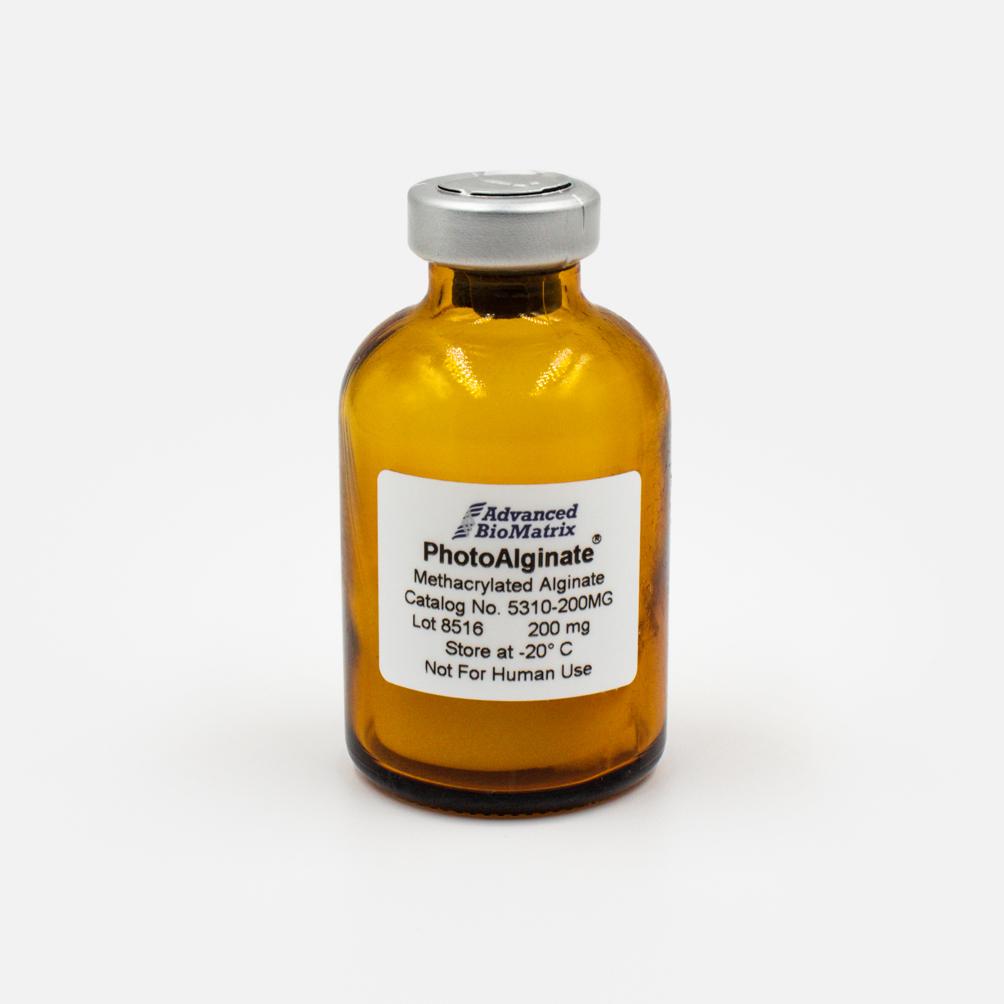
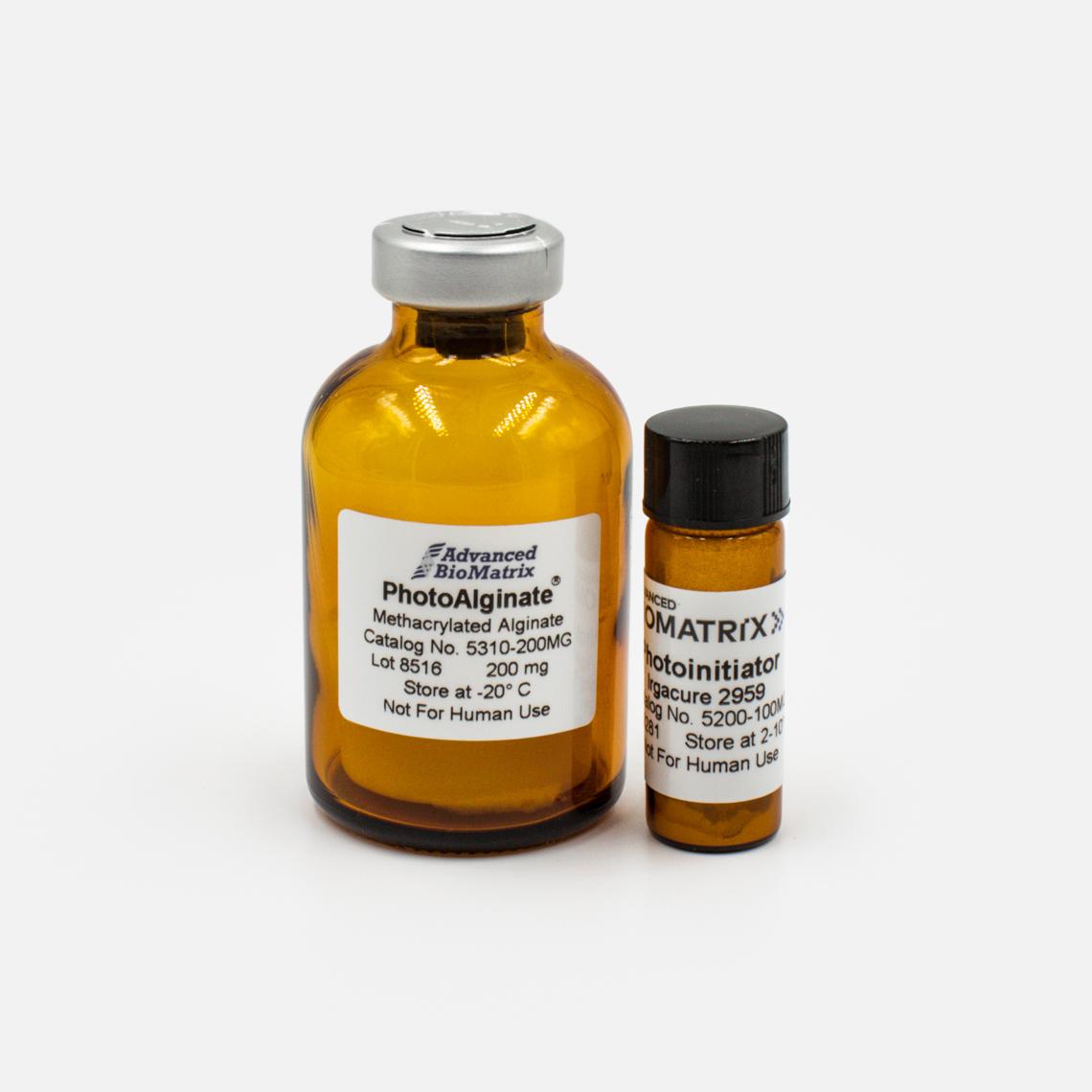
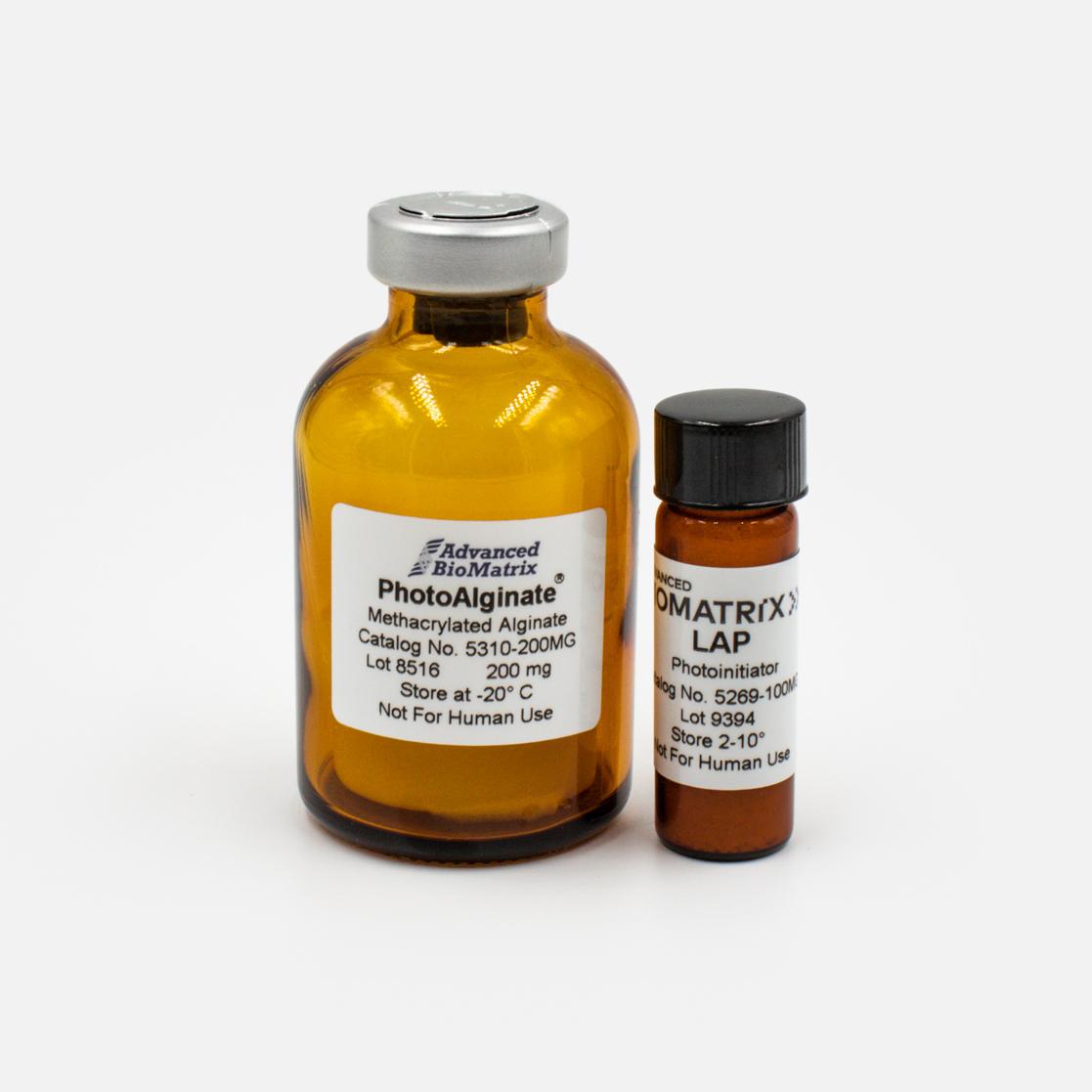
PhotoAlginate®
Methacrylated Alginate
Catalog #5310, #5353, #5354, #5355
PhotoAlginate® is a sterile, lyophilized, methacrylated alginate. It creates 3D hydrogels that can be prepared at multiple concentrations and crosslinked using light or calcium to provide various gel stiffness. PhotoAlginate® can be mixed with other photocrosslinkable ECM's.
Product Description
Advanced BioMatrix offers PhotoAlginate®, a methacrylated alginate for photocrosslinkable hydrogels or for mixing with other photocrosslinkable hydrogels (such as PhotoGel, PhotoCol or PhotoHA). PhotoAlginate® can form 3D gels and can be prepared at various concentrations and photocrosslinked to provide various gel stiffness. PhotoAlginate® is unique in that it can also be crosslinked with calcium. This product can be ordered by itself (200 mg of lyophilized sterile powder), or as a kit that comes with a photoinitiator for photocrosslinking (see table below):
| Item | Catalog Number | Photoinitiator Included |
| PhotoAlginate | #5310 | N/A |
| PhotoAlginate with Irgacure | #5353 | Irgacure (365nm) |
| PhotoAlginate with LAP | #5354 | LAP (405nm) |
| PhotoAginate with Ruthenium | #5355 | Ruthenium (400-450nm) |
Once solubilized, the PhotoAlginate® can be stored at 2-10°C for 1 month.
| Parameter, Testing, and Method | Methacrylated Alginate #5310 |
| Sterilization Method | Filtration |
| Sterility - USP modified | No growth |
| Form | Lyophilized Powder |
| Package Size | 200 mg |
| Storage Temperature | -20°C |
| Shelf Life | Minimum of 6 months from date of receipt |
| Shelf Life After Reconstitution | 1 Month |
| Degree of Methacrylation | > 20% |
| Molecular Weight | ~ 30 kDa |
Directions for Use
3D Hydrogel Preparation:
Note: Employ aseptic practices to maintain the sterility of the product throughout the preparation.
Typical working concentrations are between 10-20 mg/ml (1-2%).
Note: The following instructions are for a 1% hydrogel.
- Add 20 ml of 1X cold phosphate buffer saline (PBS) or cell culture media to the 200 mg of lyophilized methacrylated alginate powder. Ensure buffer does NOT contain calcium, as this would begin crosslinking the alginate.
- Mix on a shaker table or rotator plate until fully solubilized (~60 minutes) at 2-10°C.Note: Solubilization times may vary depending on the desired concentration and volume of PBS or medium added.
- Solubilize the photoinitiator at the recommended concentration, and add desired volume to your PhotoAlginate®. See table below for concentration and volume recommendations.
- Add your cells to the solution if desired. Cells can also be added on top of crosslinked hydrogels. For cellular attachment within the hydrogel, we recommend adding another ECM to the mixture (such as collagen).
- Dispense your PhotoAlginate/photoinitiator/cell solution into the desired cultureware (i.e. 6-well plate, 48-well plate, etc...).
- Photocrosslink until a hydrogel of the desired stiffness has formed.
- Note: Longer exposure allows more crosslinking, though each cell type withstands different degrees of UV light and free radical exposure (generated by the photoinitiator) that mediates crosslinking.
When 3D Bioprinting with PhotoAlginate®, It is recommended to print using the FRESH method, where the support bath contains a low dose of calcium to immediately crosslink the bioprinted structure prior to photocrosslinking.
| Photoinitiator | Photoinitiator Solubilization | Amount to add to PhotoAlginate Solution |
| Irgacure | 100 mg/ml in Methanol | Multiply total volume of PhotoAlginate by 0.01. Add this amount of Irgacure solution. |
| LAP | 17 mg/ml in 1X PBS or Media | Multiply total volume of PhotoAlginate by 0.02. Add this amount of LAP solution. |
|
Ruthenium Sodium Persulfate |
Ruthenium - 37.4 mg/ml in 1X PBS or Media Sodium Persulfate - 119 mg/ml in 1X PBS or Media |
Multiply total volume of PhotoAlginate by 0.02. Add this amount of both Ruthenium AND Sodium Persulfate solutions. |
NOTE: For LAP photoinitiator, the basic recommendations will result in a ~0.03% final LAP concentration. For some applications, such as DLP printing, the final LAP concentration should be increased to ~0.25-0.5% to accelerate and improve crosslinking.
Product Certificate of Analysis
No result for .
Safety and Documentation
Product Disclaimer
This product is for R&D use only and is not intended for human or other uses. Please consult the Material Safety Data Sheet for information regarding hazards and safe handling practices.
